
Image Credit: best pixels/shutterstock
CHICAGO—With the approval of the Jak inhibitors (i.e., jakinibs) tofacitinib and ruxolitinib—and others being investigated—rheumatologists need to arm themselves with an understanding of these drugs so they can think critically when evaluating them and deciding how to use them, said John O’Shea, MD, chief of the Molecular Immunology and Inflammation Branch of and scientific director for intramural research at the National Institute of Arthritis and Musculoskeletal and Skin Diseases.
Dr. O’Shea—a foremost expert on “Jaks,” or Janus kinases, who helped develop tofacitinib—spoke at the American College of Rheumatology’s 2015 State-of-the-Art Clinical Symposium in May, highlighting the history of Jak development and questions that have yet to be answered as the field moves forward.
His talk led off a session on The Big Three, which also included talks on osteoarthritis and the impact footwear can have on knee inflammation; and membranous glomerulonephritis treatment in systemic lupus erythematosus.
Jakinibs
Jaks—four of 518 protein kinases—are phosphotransferases that bring about the transfer of ATP to cytokine receptors, which allows cell signaling molecules, such as STAT proteins, to be recruited. Jak inhibitors block this ATP binding and prevent receptors from transmitting signals.

Dr. O’Shea
Approved jakinibs—ruxolitinib, which targets Jak1 and Jak2, and is approved for polycythemia and myelofibrosis; and tofactinib, which targets Jak1 and Jak3, and is approved for RA—will likely soon be joined by others. Drugs that target Jak1, along with others, are in development.
“Jakinibs are a reality—many more to come,” Dr. O’Shea said.
Dr. O’Shea said that it’s important to understand that when a drug inhibits the Jak/STAT pathway, multiple cytokines are being inhibited, and the clinical upshot of that scope of inhibition is not yet known. He said it isn’t clear yet whether this multiple-cytokine inhibition is the reason why toficitinib and baracitinib work. And, if a second generation of Jak inhibitors is more selective, he said, it isn’t known whether they will work as well or have a better safety profile.
“The things you should be asking yourself as you’re looking at posters at the ACR [Annual Meeting] are which Jak is being inhibited? What other kinases are being inhibited? The scientific question[s] really [are], ‘What is the basis of efficacy? Which cytokines? Which ones are really important in which cells?’”
Dr. O’Shea said that when jakinibs were first being developed, the prevailing idea was that a drug that blocks ATP would have “this exquisite specificity.” But it turns out that the 20 or so approved kinase inhibitors have varying levels of specificity.


